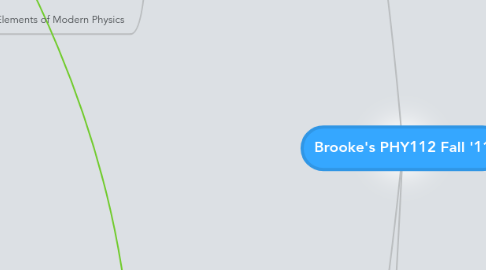
1. PHYSICS CONCEPTS
1.1. Electrical and Magnetic Properties of Matter
1.1.1. Electricity simulations including electron hockey
1.1.2. Current through resistors, high resistance vs low resistance
1.1.3. coils of wire act as inductors, collecting charge and creating a magnetic field, which in turn can effectively transfer charge to nearby matter.
1.1.4. Electromagnetic Radiation
1.1.4.1. Accelerating charge
1.1.4.2. Electromagnetic spectrum: range of frequencies divided into groups of how they interact with matter
1.1.4.2.1. Radio waves, Infrared, Visible light, ultraviolet, x-rays, gamma rays
1.1.4.3. Electromagnetic waves and their propwrties
1.1.4.3.1. refraction, reflection, diffraction, transmission
1.1.4.3.2. Young's equation: Path difference of 2 pt source interference
1.2. Fields & Forces
1.2.1. Bowling ball/ golf ball blanket distortion
1.2.2. Magnetic field and it's effect on copper wire with a flowing current. North/south pole of looped wire.
1.3. DC & AC Circuits
1.3.1. Felt the power of a charged circuit, by accidentally shocking myself by touching a lead on the circuit board for my coil gun.
1.3.2. Learned the difference between AC and DC by explaining the circuit board of the camera flash in my project 1 technical document.
1.4. Electromagnetism
1.4.1. Researched Faraday- Discovered his work led to the technology for motors.
1.5. Elements of Modern Physics
1.5.1. researched the capabilities of the Hubble space telescope and it's contribution to physics and astronomy
1.5.2. watched Paul's video about the inner workings of a cars alternator, its charging system
1.5.3. Began research on Nuclear Fission, which is the splitting of the nucleus of an atom
1.5.3.1. Found that Nuclear Reactors use neutrons to break apart uranium molecules, releasing heat in the process, which in turn is used to heat water to make steam then harnessed for generating electricity
1.5.3.1.1. Ernest Rutherford conducted the first experiments in Nuclear fission, and resulted in further experiments by Otto Hahn who with the help of Lise Meitner determined Uranium could be split into Krypton and Barium.
1.5.4. X-rays are a form of electromagnetic radiation that can penetrate most tissue/ articles that aren't extremely dense (can't penetrate metal or bone). Fall on the spectrum just below gamma rays. Some wavelengths overlap into the gamma spectrum.
1.5.5. CT Scans: Uses multiple x-ray images around an axis to get a sliced image of the item being examined. Computers render the images.
1.5.6. MRI: Uses Nuclear Magnetic Resonance to examine soft tissue of the body, works best with tissue that is not very dense and has a lot of water, ie muscle, connective tissue
1.5.7. PET Scan: Uses biological molecules with tracers that emit gamma rays injected in the body to visually examine functional systems within the body, ie glucose uptake
1.5.8. Lasers: So many uses! From pointers to checkout scanners, measures the bouncing back of the laser beam. Medical uses include using lasers to break up pigment in skin to eliminate tattoos, uses the precise cutting technology by heat to perform laser eye surgery.
1.5.9. Watched the elegant universe and learned about the development of string theory and why this search was so important.
2. TECHNICAL COMMUNICATIONS
2.1. Effectively communicate qualitative and quantitative information orally and in writing
2.1.1. Posted Neat Video to share with the class a cool physics related video on class Google Site
2.1.2. Made a neat video with a model of a "stripped down motor" experiment using a magnetic field and coiled copper wire with a current to make the coil spin.
2.1.3. created a neat video showing how a fluorescent tube can light using the electromagnetic field of high tension power lines
2.1.4. Made a sumarization of explanation for the topics assigned for weeks 12-14
2.1.5. Created a neat video about the appearance of colors in markers and how blotting paper and water can separate the colors we perceive.
2.1.6. Created a neat video using a rubber band to make vibrations and move nearby cheerios hanging on strings.
2.2. Explain the application of fundamental Physics principles to various physical phenomena
2.2.1. Taught my son how to ride a bike using newton's first law of motion
2.2.2. Made a neat video showing chromatography at work
2.3. Apply appropriate problem-solving techniques to practical and meaningful problems using graphical, mathematical, and written modeling tools
2.3.1. Ran Simulations on PhET for DC currents
2.3.2. Wrote a technical document describing the functions of a telescope, including ray diagrams
2.4. Using web2.0 and media apps, communicating all of what I've learned
2.4.1. Using mindmeister, dipity, and my google site to show what I have been working on
2.4.2. Created my portion for the coil gun project, taking on topics such as charge, current, voltage, magnetism, induction, resistance
3. SOCIETAL SKILLS
3.1. Work effectively in collaborative groups
3.1.1. Contacted Group about Project 1 organization and logistics
3.1.2. Worked with my group to create a video for project 2
3.2. Argue various sides of controversial topics using appropriate scientific argumentation techniques
3.2.1. Wrote on three different controversial debate topics, including astrology, global warming, and intelligent design, commented on other topics posted.
3.3. Educate yourself and your children
3.3.1. Showed my kids the electricity simulations and tried shocking each other
